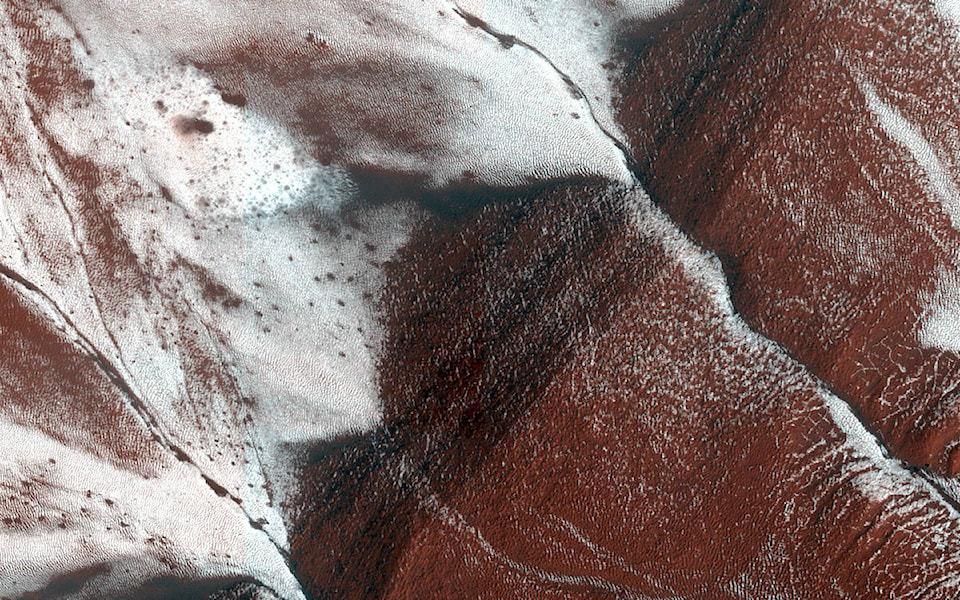By Samantha Bell
Unfortunately there are no major meteor showers in September, but you might see the Zodiacal Light if you are an early riser. It will appear just before dawn in the east as a faint conical glow reaching up from the horizon. The best time to try and spot it is from Sept. 5 to 23. This light is caused by the dust in Earth’s path reflecting the light of the sun. In some places, the Zodiacal Light is known as a false dawn. You will want to observe from a dark site, so I suggest a camping trip.
Also, FYI, the Mars Reconnaissance Orbiter has been orbiting Mars since 2006 and has sent back more data about the Red Planet than all other interplanetary missions combined. A large chunk of that data comes from the High Resolution Imaging Science Experiment (HiRISE), and it is taking requests.
This program is called HiWish, and you might want to take a look. At www.uahirise.org/hiwish you can sign up and suggest areas of Mars you would like to see photographed. You will have to write a brief science justification (“This crater looks like it has wet gullies, could we get a better image?”) and select one of the 18 science themes (which can be found on the website) that best describes it. The science team will review the submissions and decide what photos to take on the next flyby. You can see some of the images at www.uahirise.org or help analyze them at www.planetfour.org.
Venus lies low in the West-Southwest shortly after sunset. It will sink lower as September passes, but will brighten as well. It will reach its brightest Sept. 21 when it stands half as high in the sky as it did Sept. 1, and will be below and just to the right of Jupiter.
Jupiter will be fairly easy to spot in the southwest after sunset as it is brighter than any of the other “stars” (but not as bright as Venus or Mars). Jupiter will start the evening off at its highest point then sink toward the horizon overnight. The crescent moon will pass to the upper right of Jupiter Sept. 13. The best time to view this giant world is just after twilight, when it’s at its highest point, minimizing the distortion of Earth’s atmosphere in your telescope or binoculars.
Saturn rests in the south, at the top of Sagittarius, and reaches peak altitude an hour after sunset. The ringed world rests almost midway between Jupiter and Mars, and you can use Saturn’s yellowish glow to locate the Trifid Nebula (M20) to the west of the planet and the Lagoon Nebula (M8) to the southwest. Saturn’s rings are currently tilted 27 degrees to our line of sight, but you really need a telescope (even a weak or cheap one) to get the full impact.
Mars can be found low in south-southeast and is currently the second brightest planet in the evening sky after Venus, but will be easy to spot due to its reddish-orange colour. The Red Planet will start September between Sagittarius and Capricorn, just south of the globular star cluster M75. It will move in a northeast into Capricorn during the month as it retreats from Earth, dimming and shrinking as it goes. For those of us in the north Mars will actually rise a bit in the sky, giving us a chance to take a look through binoculars or telescopes.
Neptune appears in the east at sunset this month and on Sept. 7 it will be in opposition (when it lies opposite the sun from our view on Earth). Overnight the planet will move east to south to west in a lazy arc and remain in the sky from dusk to dawn. You will need binoculars or a telescope to see this blue-grey disc (or dot) in Aquarius as it is not bright enough for the human eye.
Uranus is a late riser and will be found in the east in late evening. While bright enough to see with the naked eye from a dark site, binoculars are recommended. This icy planet is currently staying in the southwestern part of Aries. To be certain that you spotted Neptune, look through binoculars or a telescope to see the planet’s distinctive blue-green colour.
Mercury will be difficult to see up north as it lies low in the east. It rises about 90 minutes before sunup and should reach its maximum height an hour later. This planet will sink rapidly this month, but will grow brighter as it descends. Use binoculars or a telescope to confirm a sighting by spotting its grayish disk, which should appear about 2/3 lit.
